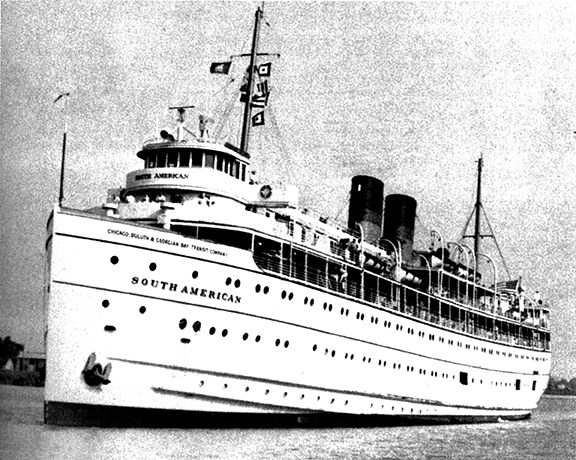Phil Egan
The Canada 150 celebrations took my mind back to Canada’s last major birthday – the 1967 Centennial and Montreal World Fair, known as Expo 67.
Our family of 12 travelled to Expo the only way we could collectively, in our big 1947 GM Coach bus nicknamed the Brown Bomber. Another family bus, Norm Christopher’s Blue Goose, travelled the highways to Montreal with us.
Thousands of other Expo visitors made a more comfortable, even historic, journey that summer. They sailed to Montreal from several Great Lakes ports on the S.S. South American, the very last of the passenger cruise ships operating on the “inland seas” of Superior, Michigan, Huron, Erie and Ontario.
At its heyday in the decades between the two world wars, Great Lakes cruising involved more than two dozen passenger vessels carrying thousands of passengers through Georgian Bay, the Great Lakes and its river systems. People enjoyed three, five or seven day pleasure cruises, or used the vessels as part of longer journeys west or east.
Granted, the places visited– Buffalo, Cleveland, Detroit, The Soo, Chicago and Mackinac Island, known as the `Bermuda of the North - lacked the glamour of Caribbean and Mediterranean ports of call. And the vessels themselves weren’t the luxurious floating palaces of cruise vacations today.
But in the days before widespread jet travel Great Lakes cruising was immensely popular.
The S.S. South American was known as the Queen of the Inland Seas. Built in 1913 for the Chicago, Duluth & Georgian Bay Transit Company, the 96-metre long ship had five decks and weighed 2,662-tons.
She was constructed as a coal-burning steam vessel with berths for 500 passengers and a crew of 165. Following a fire in 1924, a second smokestack was added and her coal-fuelled boilers converted to burn oil.
The Georgian Bay Line, as it was more commonly known, survived the Great Depression that had financially sunk many of its competitors. The South American was available for school graduation trips and other charters from mid-May to mid-June, and from Labour Day to mid-October.
During peak season from mid-June to Labour Day she operated a scheduled passenger service from Buffalo to Cleveland and Detroit, passing Sarnia on her way to Mackinac Island and other Lakehead ports.
Without doubt, however, South American`s most successful season was her final one in 1967, when she was devoted exclusively to operating 18 cruises from Great Lakes ports to the hugely popular Expo 67 in Montreal.
The South American, the last of the great fleet of Great Lakes steamships, fell victim to changing times and the growing popularity of packaged charter holidays. She was sold and eventually scrapped.
